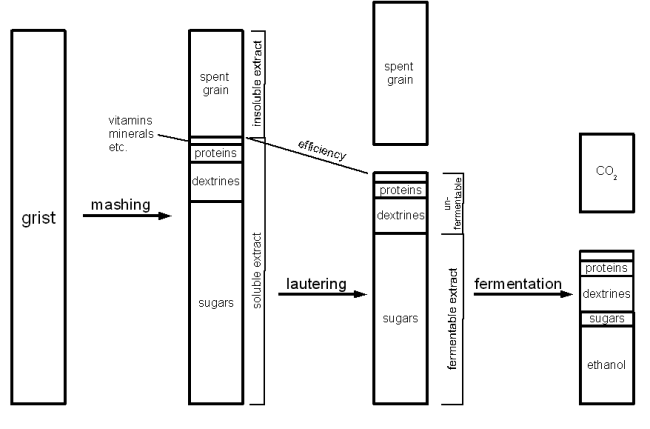| Line 15: | Line 15: | ||
to work for brewers who measure extract as specific gravity. | to work for brewers who measure extract as specific gravity. | ||
| + | |||
| + | |||
| + | == Brewing process and wort composition == | ||
To understand the different forms of attenuation we need to take a look at the extract composition first. During [[mashing]], the majority of the [[grist]] is converted into water soluble compounds and then to beer. This is shown in Figure 1. | To understand the different forms of attenuation we need to take a look at the extract composition first. During [[mashing]], the majority of the [[grist]] is converted into water soluble compounds and then to beer. This is shown in Figure 1. | ||
Revision as of 00:28, 28 November 2007
work in progress
--Kaiser 22:51, 25 November 2007 (CST)
Attenuation refers to the percentage of starting extract that has been converted by the fermentation process:
Attenuation = 100 % * (starting extract - current extract) / (starting extract)
This formula works with extract given in weight percentages and degree Plato. Since, at least in the wort and beer gravities that most brewers work with, there is an almost linear relationship between (specific gravity - 1) and extract percentages. This formula can be changed to:
Attenuation = 100 % * (starting gravity - current gravity) / (starting gravity - 1)
to work for brewers who measure extract as specific gravity.
Brewing process and wort composition
To understand the different forms of attenuation we need to take a look at the extract composition first. During mashing, the majority of the grist is converted into water soluble compounds and then to beer. This is shown in Figure 1.
The conditions during the mashing process as well as the grains will determine the exact ratio between the various compopunds (sugars, detxtrines, proteins and others). Once the conversion is complete, the mash is lautered. During this process not all of the dissolved extract is extracted. The perentage of the total dissolved extract and the extract that actually ends up in the boil kettle is called brew house efficiency.
During the boil only minor changes happen to the wort composition. The denaturization of the enzymes finally fixes the ratio between fermentable and unfermentable extract. Coagulation of proteines change the amount and composition of proteins in the wort. Hops will add additional compounds. But these are of little interest for the discussion of attenuation.
When during the wort fermentation, the fermentable sugars are converted into almost equal parts of CO2 and ethanol as well as much smaller amounts of other compounds (esters, higher alcohols). The yeast will also absorb most of the simple proteins. But not all of the fermentable sugars will have been fermented at the time the beer is comsumed. The amount of fermentable sugars left in the beer has an affect on the beer character and different styles of beer oftentimes have different amounts of fermentable sugars left.
When the extract of beer is measured with a [hydrometer], the ethanol contained in that beer will skew the measured extract value. Because of that the bewer calls this the apparent extract, but due to the simplicity of measuring it, this is the extact value that brewers work with. Like the real extract it is expressed as weight percent or degree Plato.

